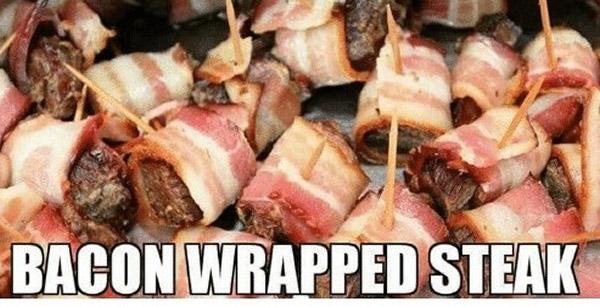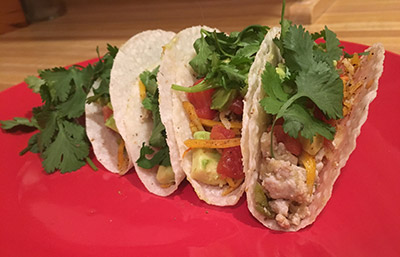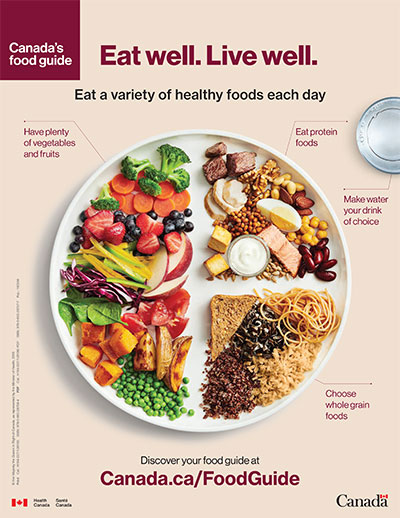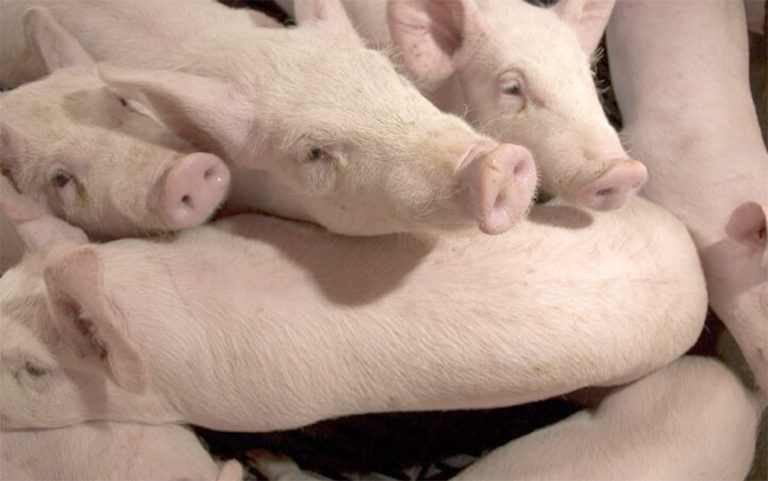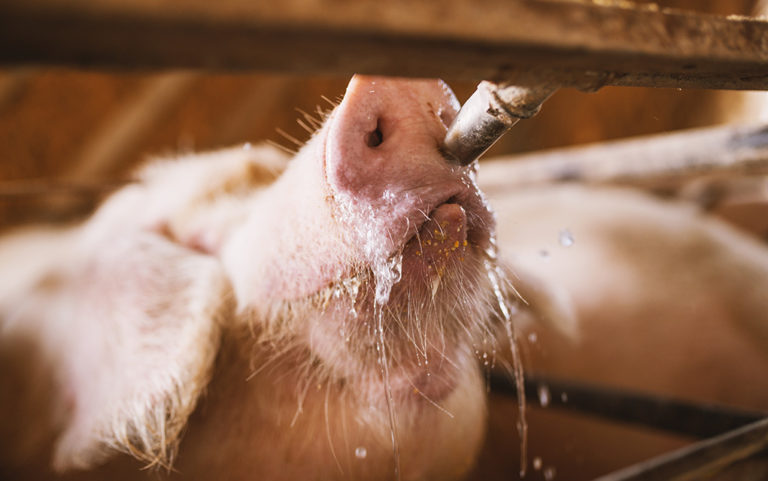Anh M. H. Le1, Lifang Wang1, JoséLandero1,2, Eduardo Beltranena1,3, and Ruurd T.Zijlstra1*
1Department of Agricultural, Food and Nutritional Science, University of Alberta, Edmonton, AB;
2Gowans Feed Consulting, Wainwright, AB; 3Alberta Agriculture and Forestry, Edmonton, AB
Take home message
Feeding increasing inclusions of yellow-seeded Brassica juncea canola cake up to 24 per cent in substitution for soybean meal in diets for weaned pigs maximized feed intake at 12 per cent inclusion and weight gain at 18 per cent inclusion. Remaining oil in cake costs about one-third of liquid oil added to pig diets, so feed cost was ~9 cents per kg gain or $1.6 per pig cheaper feeding 24 per cent cake in 35 days than soybean meal-only nursery diets with equal energy value.
Cake vs. meal –what’s the difference?
Most people celebrate birthdays eating cake. Pigs like cake too, but not such a sugary treat. Let us explain. Cleaned canola seed with ~45 per cent oil is pressed (Figure 1) first to remove a large portion of the oil. ‘Cake’is what we name the resulting product, which depending on how good the press is, leaves some oil in it (10 to 20 per cent). If cake is washed next with a solvent to squeeze out nearly all the remaining oil and dried, that’s what we call ‘meal’. This solvent-extracted meal is what you buy for animal feeding from big crushers that refine oil for human consumption. But if seed is simply pressed, not washed with solvent, the remaining oil in cake has far greater energy value compared with oil-depleted meal for feeding pigs. And if you bought canola cake at nearly the price of meal, the remaining oil in cake would cost you about one-third per kg compared with stocking liquid canola oil to add to pig diets.

Dark vs. yellow canola –what’s the difference?
Most canola cultivars grown in western Canada have a dark seed coat (Brassica napus). These cultivars grow well on organic matter-rich Black, Dark Gray and Dark Brown topsoils of the subhumid central plains. But yellow-seeded canola cultivars (Brassica juncea) grow better on the dryer, warmer Brown soils of the southern Prairies. Yellow-seeded canola seems more tolerant to heat and drought stress and offers greater resistance to disease. Yellow canola alsohas a thinner seed coat and thus lower fibre content than dark-seeded canola resulting in greater feed energy value. However, yellow-seeded canola contains about triple the glucosinolate content than dark-seeded canola, and it is specifically high in a very bitter one named ‘gluconapin’that is well known to reduce the feed intake of pigs.
The weaned pig trial
Given that cake with remaining oil provides more feed energy than oil-depleted meal and that yellow-seeded canola provides more feed energy because of its thinner seed coat and thus lower fibre, we decided to evaluate feeding increasing levels of juncea canola cake to the most sensitive pig, weaned pigs. Knowing too about the high content of bitter-tasting gluconapin in yellow canola, we thought to not just press the seed, but extrude it first and then press it to deactivate as much gluconapin as possible. To achieve this, we sourced the juncea seed from southern Saskatchewan and took it to Apex Nutri-Solutions Inc. in Edberg, AB to extrude and press. The resulting cake contained 17 per cent fat, 35 per cent protein and 1.6 per cent available lysine. However, it still contained 11 µmol total glucosinolates per gram, of which most (9.7 µmol/g) was the bitter-tasting gluconapin.
We conducted this trial at the Swine Research and Technology Centre, University of Alberta (Edmonton, AB). Starting seven days post-weaning, 240 pigs weighing ~7.5 kg housed in 60 pens, four pigs per pen, were fed Phase 1 diets for two weeks (day 1–14) and subsequently Phase 2 diets for three weeks (day 15–35). The 5 wheat-based test diets for each of the 2 growth phases included 0, 6, 12, 18, or 24 per cent juncea cake in substitution for soybean meal. Increasing inclusions of juncea cake reduced diet protein, and increased fat and fibre content slightly. Diets without antimicrobials or growth promoters were formulated to 2.4 Mcal NE/kg and 5 g SID lysine/Mcal NE in Phase 1 and 2.3 Mcal NE/kg and 4.5 g SID lysine/Mcal NE in Phase 2. Pigs had free access to the pelleted diets and water throughout the 35-day trial. Individual pig body weight, pen feed added and remaining were weighed weekly. Faeces were collected at the end of each feeding phase to determine total tract digestibility of feed energy and protein.
What we found
Increasing the dietary inclusion of more fibrous yellow-seeded canola cake replacing less fibrous dehulled, solvent-extracted soybean meal marginally reduced the total tract digestibility of both feed energy (from 86.3 at 0 to 83.3% at 24% cake inclusion) and protein (from 83.8 at 0 to 78.8% at 24% inclusion) for both phases. As a result, diet digestible energy (from 3.5 at 0 to 3.45 Mcal DE at 24 per cent inclusion) and calculated net energy values (from 2.5 at 0 to 2.46 Mcal NE at 24 per cent inclusion) linearly decreased for both Phase 1 and Phase 2.
For the entire trial (days 0–35), increasing the dietary inclusion of junceacake resulted in curvilinear growth responses (Figure 2). It maximized pig daily feed intake at 12 per cent with a slightly decrease at greater cake inclusions most likely because of the bitter taste of gluconapin in cake. Daily weight gain was maximized at 18 per cent cake inclusion with no appreciable decline at 24 per cent inclusion. The increased daily weight gain was reflected in the final body weight of pigs being 24.4, 25.5, 25.9, 25.9 and 25.5 kg for pigs fed 0, 6, 12, 18 and 24 per cent cake, respectively. Our previous study showed that feeding increasing dietary inclusions of juncea canola meal linearly reduced feed intake and growth in weaned pigs. That was not the case this time feeding cake instead. Extrusion prior to pressing the yellow canola seed might have helped reduce the negative effects of the bitter-tasting gluconapin in B. juncea seed on feed intake.
Icing on the cake
Increasing the dietary inclusion of canola cake drastically reduced the amount of liquid oil needed to balance the energy value of the diets. Based on assumed market prices ($/tonne) of wheat 250, soybean meal 510, juncea cake 330, canola oil 1,100, and L-lysine-HCl 2200, the dietary inclusion of 6, 12, 18, and 24 per cent cake in substitution of SBM reduced feed cost by $10.72, 23.52, 34.33, and 46.04 per tonne, respectively for both growth phases. That implied feed cost savings of 0.59, 3.66, 6.38, and 8.68 cents per kg of body weight gain, or 0.1, 0.65, 1.16, and 1.59 dollars per pig, respectively in weaned pigs for the 35-day trial. You could call that icing on the cake!
Conclusions
We produced ~20 million tonnes of canola and ~7 million tonnes of soybean seed in Canada (2019-2020). #1 and #2 seed are rightfully directed for human food oil consumption and most of the meal (~95%) is exported. The more tonnage we produce, the more lower-grade canola and soybean seed would be available for local production of cakes for animal feeding. Cakes not only provide protein but also have remaining oil that boosts feed energy complementing that from cereal starch in pig diets.
Results from this trial showed that feeding increasing inclusions of yellow-seeded B. juncea canola cake up to 24 per cent in substitution for soybean meal in diets for weaned pigs maximized feed intake at 12 per cent inclusion and weight gain at 18 per cent inclusion. Given that the remaining oil in cake costs about one-third of liquid oil added to pig diets, cost per kg gain was nearly nine cents lower at 24 per cent cake inclusion than feeding soybean meal-only nursery diets with equal energy value. The feeding value of oilseed cake is greatest for weaned pigs given that they have reduced gut capacity compared with finishing pigs and sows. Concentrating feed energy in every bite results in more growth when young pigs can only eat so much.

Acknowledgements
We appreciate the funding from Agriculture and Agri-Food Canada and the Canola Council of Canada. We thank Calvin Boese and the staff at Apex Nutri-Solutions Inc. for extruding and expeller-pressing the yellow-seeded juncea canola.







